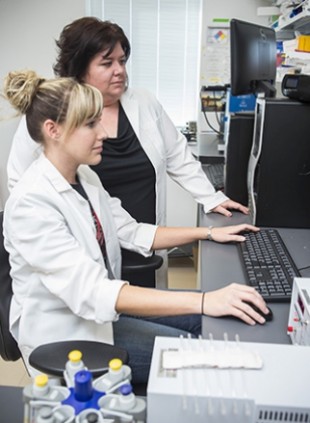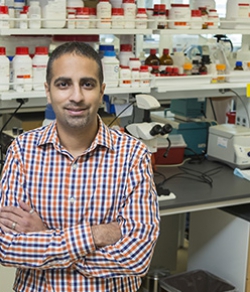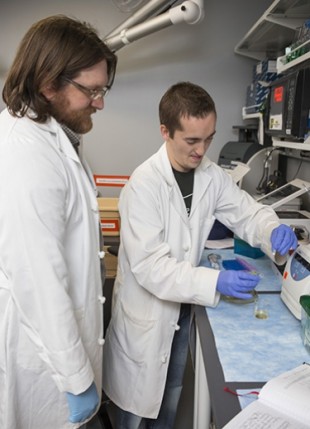The Human Touch Revealing All that is Real
Paradigm Shift
Publisher's note: The author of this post, Doug Boyd, is a contributor to ECU News Services.
Most enzymes spend their lives breaking down proteins to benefit their host organisms, so East Carolina University biochemist Lance Bridges has an apt description for one he's investigating that apparently does nothing.
"'The Walking Dead' – that's the best way I can put it," Bridges, an assistant professor of biochemistry and molecular biology at the Brody School of Medicine at East Carolina University, said, referring to the popular TV series about zombies in a post-apocalyptic world. "You have a whole family, or class, and then an oddball sticking out. It doesn't make sense why your body would take the time and energy to make an inactive enzyme.
"They're in the cells; they're there for a reason, but no one really knows," he added.
 He's in the office of Tonya Zeczycki, another assistant professor of biochemistry. Despite similar job titles, their roles are different. Bridges is a protein expert. Zeczycki is a physical biochemist/enzymologist who specializes in, as she says, "how this little machine works and moves."
He's in the office of Tonya Zeczycki, another assistant professor of biochemistry. Despite similar job titles, their roles are different. Bridges is a protein expert. Zeczycki is a physical biochemist/enzymologist who specializes in, as she says, "how this little machine works and moves."
And that's why their presence together is significant. If Bridges' protease actually does something, Zeczycki will figure out what gets it into action.
This type of scientific collaboration has taken hold in research labs around the world and across ECU. Called research networks, they are helping scientists solve more complex problems and gain research funding by bringing together experts in disparate fields who work together to answer specific questions.
"Not only is organizing and developing research networks across campus an institutional priority, research and graduate studies in partnership with other state agencies as well as campus colleges and schools are proactively supporting, promoting, hosting and, in some cases, sponsoring the development of research networks," said Ernest Marshburn, director of the Office of Research Development at ECU. Those efforts include STEM@Starlight, Research Mingle and research meetings at the Tipsy Teapot cafe.
According to Jason Owen-Smith, a professor of sociology at the University of Michigan who studies network theory, networks are a concrete pattern of relationships. Hubs, or key players, form branches to others. Networks serve as resource and information channels, they can signal that a researcher has status and they can influence other researchers, he said.
Research networks aim to bring together people who have an interest in studying a particular condition or population. They might be local, national or international.
"They have no hesitation of contacting scientists all over the country," Phil Pekala, chair of the biochemistry department at the Brody School of Medicine, said of his faculty members. "In these days of tight funding...gone are the days of the individual who does everything by himself."
Part of the reason they and other scientists who study various aspects of metabolism are getting together is because of the "laboratory without walls" setting on the fourth floor of the East Carolina Heart Institute at ECU, where they work.
"Two people working in very different parts of biochemistry – kinetics and proteins – we've never had that proximity of talent before," Pekala said. "That sort of open laboratory is supposed to promote collaboration and interest among people."
 Scientists working together isn't new. But what used to be dividing the work or sharing research samples is now people with diverse skills working on a problem from different angles.
Scientists working together isn't new. But what used to be dividing the work or sharing research samples is now people with diverse skills working on a problem from different angles.
"You still collaborated. There was never a time when I wasn't reaching out to find someone to work with," said Pekala, who joined ECU in 1981 after completing postdoctoral studies. "The collaborations are more dynamic now than they were then. Now these people are co-investigators with each other. They write grant applications together."
Anne Spuches, an associate professor of chemistry, is an inorganic chemist specializing in ways metals are "trafficked" within cells. Some metals, such as magnesium, are vital to human health. Others are toxic. Even healthful metals can cause problems when there's too much or too little of them.
For example, calcium plays a role in regulating heartbeat. Last year, Spuches, Joe Chalovich, a biochemist at the Brody School of Medicine at ECU and a heart muscle specialist, ECU chemist Yumin Li and others published a study that looked at calcium binding within heart muscle.
 She's also working with Dr. Walter Pories, ECU's gastric-bypass surgery pioneer, to better understand if people who get the surgery are absorbing enough nutrients from their meals, and Marty Roop, a microbiologist specializing in the infectious bacteria brucella. She and Lance Bridges plan to start working together.
She's also working with Dr. Walter Pories, ECU's gastric-bypass surgery pioneer, to better understand if people who get the surgery are absorbing enough nutrients from their meals, and Marty Roop, a microbiologist specializing in the infectious bacteria brucella. She and Lance Bridges plan to start working together.
"The more angles you know...the more of a complete story you'll obtain," Spuches said. "That is the trend I've been seeing several years now."
In the Thomas Harriot College of Arts and Sciences, scientists worked together to secure a $281,393 National Science Foundation grant to buy an ocean-going robot for coastal and fisheries research. It's part of research by biologist and fish ecology expert Joe Luczkovich, biologist and fisheries expert Roger Rulifson, physicist and acoustics expert Mark Sprague and geologist J.P Walsh to study sounds fish make, how those sounds travel through sediment and how that can determine where they are, how many there are and what they're communicating.
"Adding a physicist with a background in acoustics to that made all the sense in the world," said Luczkovich, an associate professor of biology. "It's not strictly a biology question. It's a physics question as well as a biology question."
Doug Edgeton, president and chief executive of the North Carolina Biotechnology Center, which, among other roles, funds scientists in universities and private industry, said intensive collaboration is vital today.
"In general, most of the life-science problems we're dealing with today don't lend themselves to one disciplinary approach anymore," said Edgeton. That's why in the last 20 years or so, he said, centers and core research facilities such as the heart institute at ECU and the Institute for Regenerative Medicine at Wake Forest University that he helped found have sprouted. They bring people with a depth of expertise in various fields together to tackle cancer, heart disease, obesity and other problems, he said.
Collaboration doesn't end with the publication of the research article, however. "After you solve the problem, now how do you produce this for the marketplace?" Edgeton said. That brings in engineers, business people, marketers and more.
As science is always evolving, so, too, is the technology that allows collaboration and networking. ECU biochemist Saame Raza Shaikh uses the social media platform LinkedIn to make contacts with researchers and companies.
 "That led to meeting people at conferences," said Shaikh, an associate professor of biochemisty and molecular biology.
"That led to meeting people at conferences," said Shaikh, an associate professor of biochemisty and molecular biology.
"Bottom line is right now I'm negotiating a clinical study. The broader concept is that networking is critical for establishing a research track and establishing credibility. Then they start getting interested and talking with you. It's a good way to market and advertise."
He said using modern communications technology to build networks is easier than what his predecessors had to do to build relationships. This year, Shaikh has published articles with scientists at the University of North Carolina at Chapel Hill, WFU and Michigan State University.
"Collaborations are much easier to come by because you can communicate much faster online," Shaikh said. "Science today is more integrated. They fund research teams. They don't fund single individuals anymore."
Collaborative projects are drawing favor from funding agencies. Criteria for awarding research grants at the National Institutes of Health include the following question: "If the project is collaborative...do the investigators have complementary and integrated expertise; are their leadership approach, governance and organizational structure appropriate for the project?"
"These are the 'big money' grants that are awarded to investigators whose science is expected to make a significant, paradigm-shifting impact on the field or health and disease research as a whole," said Zeczycki. "There has been a push to come at a single project from several different aspects, (such as) from a mechanistic and more translational approach — the 'from-lab-bench-to-bedside' mentality. Collaborations where a problem is addressed from several different, yet complementary research areas seem to do better with the NIH.
 "It is one of those things that we hear from program officers and NIH study section members – collaborative grants are more competitive when it comes to funding," she said.
"It is one of those things that we hear from program officers and NIH study section members – collaborative grants are more competitive when it comes to funding," she said.
Barbara Gray, who directs the Office of Sponsored Programs at ECU, agreed.
"Funders, particularly federal government agencies and large private foundations, are increasingly focusing their funding programs on addressing major human or societal problems or on programs that will yield some significant economic benefit," she said.
"The problems are multi-faceted, requiring experts from many disciplines to work together to develop and test possible solutions. So we are seeing more complex collaborative proposals with researchers from different disciplines and with researchers from other institutions participating.
"Collaboration between basic and clinical scientists is also an area of current funding emphasis; such collaboration speeds up the translation of new discoveries to practice," she added.
Shaikh and ECU physiology faculty member David Brown recently received a $366,744 NIH grant to investigate new ways to protect the heart during a heart attack. Zeczycki has been a co-author with other scientists including Shaikh and Brown on two research articles published this year. Bridges and Shaikh were among the authors on a fish oil study published last year.
Luczkovich just finished working with colleagues to submit another grant proposal to the NSF's "Physics and Living Systems" program.
Networks extend to students as well. Two doctoral programs, one in biological sciences and the other in coastal resource management, bring together faculty from departments ranging from chemistry to recreation and leisure studies to give students an interdisciplinary education and experience in forming their own networks.
"We all need each other's help in one way or another, especially in this funding climate," Spuches said.
"Sometimes, the best ideas come from just having a chat with somebody."

ECU professors Tonya Zeczycki, left, and Lance Bridges are collaborating across disciplines in their research on inactive enzymes in the human body. Their work is part of a research network that brings together experts in diverse fields of study, so that a subject might be viewed from a variety of angles. (Photos by Cliff Hollis)
Go Back
Collaborative research networks gain ground at ECU
Most enzymes spend their lives breaking down proteins to benefit their host organisms, so East Carolina University biochemist Lance Bridges has an apt description for one he's investigating that apparently does nothing.
"'The Walking Dead' – that's the best way I can put it," Bridges, an assistant professor of biochemistry and molecular biology at the Brody School of Medicine at East Carolina University, said, referring to the popular TV series about zombies in a post-apocalyptic world. "You have a whole family, or class, and then an oddball sticking out. It doesn't make sense why your body would take the time and energy to make an inactive enzyme.
"They're in the cells; they're there for a reason, but no one really knows," he added.

ECU researcher Tonya Zeczycki and second year Ph.D. student Stephanie Adams study enzyme kinetics.
And that's why their presence together is significant. If Bridges' protease actually does something, Zeczycki will figure out what gets it into action.
This type of scientific collaboration has taken hold in research labs around the world and across ECU. Called research networks, they are helping scientists solve more complex problems and gain research funding by bringing together experts in disparate fields who work together to answer specific questions.
"Not only is organizing and developing research networks across campus an institutional priority, research and graduate studies in partnership with other state agencies as well as campus colleges and schools are proactively supporting, promoting, hosting and, in some cases, sponsoring the development of research networks," said Ernest Marshburn, director of the Office of Research Development at ECU. Those efforts include STEM@Starlight, Research Mingle and research meetings at the Tipsy Teapot cafe.
According to Jason Owen-Smith, a professor of sociology at the University of Michigan who studies network theory, networks are a concrete pattern of relationships. Hubs, or key players, form branches to others. Networks serve as resource and information channels, they can signal that a researcher has status and they can influence other researchers, he said.
More angles yield fuller answers
Research networks aim to bring together people who have an interest in studying a particular condition or population. They might be local, national or international.
"They have no hesitation of contacting scientists all over the country," Phil Pekala, chair of the biochemistry department at the Brody School of Medicine, said of his faculty members. "In these days of tight funding...gone are the days of the individual who does everything by himself."
Part of the reason they and other scientists who study various aspects of metabolism are getting together is because of the "laboratory without walls" setting on the fourth floor of the East Carolina Heart Institute at ECU, where they work.
"Two people working in very different parts of biochemistry – kinetics and proteins – we've never had that proximity of talent before," Pekala said. "That sort of open laboratory is supposed to promote collaboration and interest among people."

Joe Chalovich, left, a biochemist at the Brody School of Medicine, and Anne Spuches, right, an associate professor of chemistry, teamed up with ECU chemist Yumin Li and other researchers on a study of calcium binding in heart muscle.
"You still collaborated. There was never a time when I wasn't reaching out to find someone to work with," said Pekala, who joined ECU in 1981 after completing postdoctoral studies. "The collaborations are more dynamic now than they were then. Now these people are co-investigators with each other. They write grant applications together."
Anne Spuches, an associate professor of chemistry, is an inorganic chemist specializing in ways metals are "trafficked" within cells. Some metals, such as magnesium, are vital to human health. Others are toxic. Even healthful metals can cause problems when there's too much or too little of them.
For example, calcium plays a role in regulating heartbeat. Last year, Spuches, Joe Chalovich, a biochemist at the Brody School of Medicine at ECU and a heart muscle specialist, ECU chemist Yumin Li and others published a study that looked at calcium binding within heart muscle.

Yumin Li
"The more angles you know...the more of a complete story you'll obtain," Spuches said. "That is the trend I've been seeing several years now."
In the Thomas Harriot College of Arts and Sciences, scientists worked together to secure a $281,393 National Science Foundation grant to buy an ocean-going robot for coastal and fisheries research. It's part of research by biologist and fish ecology expert Joe Luczkovich, biologist and fisheries expert Roger Rulifson, physicist and acoustics expert Mark Sprague and geologist J.P Walsh to study sounds fish make, how those sounds travel through sediment and how that can determine where they are, how many there are and what they're communicating.
"Adding a physicist with a background in acoustics to that made all the sense in the world," said Luczkovich, an associate professor of biology. "It's not strictly a biology question. It's a physics question as well as a biology question."
Doug Edgeton, president and chief executive of the North Carolina Biotechnology Center, which, among other roles, funds scientists in universities and private industry, said intensive collaboration is vital today.
"In general, most of the life-science problems we're dealing with today don't lend themselves to one disciplinary approach anymore," said Edgeton. That's why in the last 20 years or so, he said, centers and core research facilities such as the heart institute at ECU and the Institute for Regenerative Medicine at Wake Forest University that he helped found have sprouted. They bring people with a depth of expertise in various fields together to tackle cancer, heart disease, obesity and other problems, he said.
Collaboration doesn't end with the publication of the research article, however. "After you solve the problem, now how do you produce this for the marketplace?" Edgeton said. That brings in engineers, business people, marketers and more.
Technology has changed how scientists work together
As science is always evolving, so, too, is the technology that allows collaboration and networking. ECU biochemist Saame Raza Shaikh uses the social media platform LinkedIn to make contacts with researchers and companies.

Saame Raza Shaikh
"Bottom line is right now I'm negotiating a clinical study. The broader concept is that networking is critical for establishing a research track and establishing credibility. Then they start getting interested and talking with you. It's a good way to market and advertise."
He said using modern communications technology to build networks is easier than what his predecessors had to do to build relationships. This year, Shaikh has published articles with scientists at the University of North Carolina at Chapel Hill, WFU and Michigan State University.
"Collaborations are much easier to come by because you can communicate much faster online," Shaikh said. "Science today is more integrated. They fund research teams. They don't fund single individuals anymore."
Networks yield dollars
Collaborative projects are drawing favor from funding agencies. Criteria for awarding research grants at the National Institutes of Health include the following question: "If the project is collaborative...do the investigators have complementary and integrated expertise; are their leadership approach, governance and organizational structure appropriate for the project?"
"These are the 'big money' grants that are awarded to investigators whose science is expected to make a significant, paradigm-shifting impact on the field or health and disease research as a whole," said Zeczycki. "There has been a push to come at a single project from several different aspects, (such as) from a mechanistic and more translational approach — the 'from-lab-bench-to-bedside' mentality. Collaborations where a problem is addressed from several different, yet complementary research areas seem to do better with the NIH.

Bridges works with graduate student Jason Hoggard on isolating DNA.
Barbara Gray, who directs the Office of Sponsored Programs at ECU, agreed.
"Funders, particularly federal government agencies and large private foundations, are increasingly focusing their funding programs on addressing major human or societal problems or on programs that will yield some significant economic benefit," she said.
"The problems are multi-faceted, requiring experts from many disciplines to work together to develop and test possible solutions. So we are seeing more complex collaborative proposals with researchers from different disciplines and with researchers from other institutions participating.
"Collaboration between basic and clinical scientists is also an area of current funding emphasis; such collaboration speeds up the translation of new discoveries to practice," she added.
Shaikh and ECU physiology faculty member David Brown recently received a $366,744 NIH grant to investigate new ways to protect the heart during a heart attack. Zeczycki has been a co-author with other scientists including Shaikh and Brown on two research articles published this year. Bridges and Shaikh were among the authors on a fish oil study published last year.
Luczkovich just finished working with colleagues to submit another grant proposal to the NSF's "Physics and Living Systems" program.
Networks extend to students as well. Two doctoral programs, one in biological sciences and the other in coastal resource management, bring together faculty from departments ranging from chemistry to recreation and leisure studies to give students an interdisciplinary education and experience in forming their own networks.
"We all need each other's help in one way or another, especially in this funding climate," Spuches said.
"Sometimes, the best ideas come from just having a chat with somebody."

ECU professors Tonya Zeczycki, left, and Lance Bridges are collaborating across disciplines in their research on inactive enzymes in the human body. Their work is part of a research network that brings together experts in diverse fields of study, so that a subject might be viewed from a variety of angles. (Photos by Cliff Hollis)
| Freshman GOP Sen. Barefoot Hopes To Hold Seat in Democratic District | East Carolina University, School News, The Region, Neighboring Counties | ECU Professors Share Expert Opinions On Politics And Humor |





















